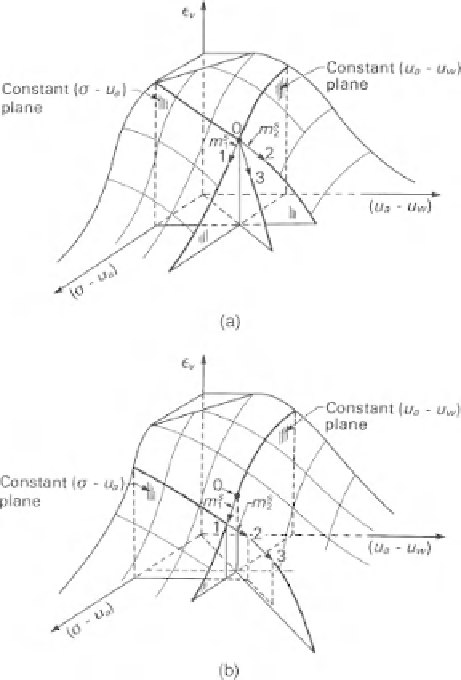Environmental Engineering Reference
In-Depth Information
in Fig. 13.7. A positive or negative sign is associated with
the deformation or stress state variable change in order to
indicate an increase or decrease. The following sign conven-
tion can be formulated for multiphase materials. A positive
change in the state variable (i.e., deformation or stress)
refers to an increase in the state variable, whereas a negative
change indicates a decrease in the state variable. The signs
of the deformation state variables and the stress state
variables determine the sign for the volumetric deformation
coefficients. For example, the stable-structured soil behavior
shown in Fig. 13.7 has a negative sign for the modulus of
elasticity
E
. This means that an increase in the net normal
stress,
(
+
) d
σ
−
u
a
, causes a decrease in volumetric
strain,
(
−
) dε
v
[i.e.,
(
−
) E
=
(
−
) dε
v
/ (
+
) d
σ
−
u
a
].
The elastic modulus
H
also has a negative sign [e.g.,
(
−
) H
=
(
−
) dε
v
/ (
+
) d
u
a
−
u
w
].
The relationship between the water volume change and
the stress state variable change for a stable-structured soil
is similar to that shown in Fig. 13.7. The water volumetric
moduli
E
w
and
H
w
would also have negative signs. There-
fore, it can be concluded that a
stable-structured
soil has
negative
volumetric deformation
moduli
associated with the
soil structure and water phase. The negative sign applies
similarly to all coefficients of volume change,
m
1
,
m
2
,
m
1
,
and
m
2
, which are used in the compressibility form of the
constitutive equations. The
a
t
,
a
m
,
b
t
, and
b
m
coefficients
associated with the soil mechanics form of the constitutive
equations are also negative for a stable-structured soil.
A collapsing soil is referred to as a metastable-structured
soil. A decrease in matric suction results in swelling for a
stable-structured soil whereas it may cause a volume decrease
in a metastable-structured soil (Barden et al., 1969a). The
m
2
and
m
2
coefficients of volume change have a positive sign
for collapsing soils (Eqs. 13.53 and 13.54). A
metastable-
structured
soil can be referred to as a soil that has one or
more
positive
volumetric deformation moduli.
Figure 13.13
Testing for uniqueness of soil structure constitutive
surface: constitutive surface verification using (a) three identical
soil specimens and (b) a single soil specimen.
increase in net normal stress,
d
σ
−
u
a
, by increasing
the total normal stress while the matric suction
u
a
−
u
w
is
maintained constant (i.e., 0-1 loading path in Fig. 13.13a).
The measured volumetric strain change
dε
v
can be used to
compute the coefficient of volume change
m
1
:
13.4.5 Verification of Uniqueness of Constitutive
Surfaces Using Small Stress Changes
Let us suppose that several so-called identical unsaturated
soil specimens are subjected to the same total normal stress
and the same pore-air and pore-water pressures. All spec-
imens will be at the same state point in space and have
the same initial volume-mass properties. Let each specimen
then be subjected to different stress path changes while the
volume changes are monitored. If the constitutive surface is
essentially planar near a state point, the volumetric deforma-
tion moduli associated with any two orthogonal directions
can be used to describe the deformation produced by other
stress state variable changes.
A somewhat simpler test for uniqueness can be described
as follows. Suppose that three so-called identical specimens
are prepared at the same initial volume-mass properties
and subjected to the same initial stress state variables
(Fig. 13.13a). Let one specimen be subjected to a small
dε
v
m
1
=
d
σ
−
u
a
(13.60)
A second specimen could be subjected to a small increase
in matric suction,
d
u
a
−
u
w
, by decreasing the pore-water
pressure
u
w
while maintaining a constant net normal stress
(i.e., 0-2 loading path in Fig. 13.13a). The measured change
in volumetric strain,
dε
v
, can be used to calculate the
m
2
coefficient of volume change:
dε
v
m
2
=
d
u
a
−
u
w
(13.61)
A third specimen could then be subjected to small increases
in both the net normal stress
d
σ
−
u
a
and the matric suc-
tion
d
u
a
−
u
w
. This can be achieved by increasing the
total normal stress
σ
and decreasing the pore-water pres-
sure
u
w
. The anticipated volume change can be predicted












Search WWH ::

Custom Search